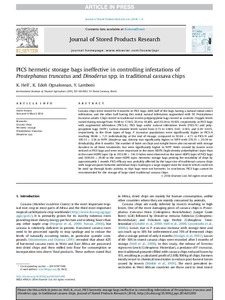| dc.contributor.author | Hell, K. |
| dc.contributor.author | Ognakossan, K. |
| dc.contributor.author | Lamboni, Y. |
| dc.date.accessioned | 2019-12-04T10:58:28Z |
| dc.date.available | 2019-12-04T10:58:28Z |
| dc.date.issued | 2014 |
| dc.identifier.citation | Hell, K., Ognakossan, K. & Lamboni, Y. (2014). PICS hermetic storage bags ineffective in controlling infestations of prostephanus truncatus and dinoderus spp. in traditional cassava chips. Journal of Stored Products Research, 58, 53-58. |
| dc.identifier.issn | 0022-474X |
| dc.identifier.uri | https://hdl.handle.net/20.500.12478/995 |
| dc.description | Early view |
| dc.description.abstract | Cassava chips were stored for 8 months in PICS bags, with half of the bags having a natural initial insectinfestation, and the other half having this initial natural infestation augmented with 50 Prostephanustruncatus adults. Chips stored in traditional woven polypropylene bags served as controls. Oxygen levelsvaried during storage from 19.98 to 17.56%, 20.4 to 18.40%, and 20.24 to 19.92%, respectively, in PICS bagswith augmented infestation (PICS-A), PICS bags under natural infestation levels (PICS-N) and polypropylenebags (WPP). Carbon dioxide levels varied from 0.73 to 3.90%, 0.65e3.56%, and 0.20e0.61%,respectively, in the three types of bags. P. truncatus populations were significantly higher in PICS-Areaching 98.66 7.21 individuals/kg at the end of storage, compared to 92.66 4.71 in PICS-N and100.55 3.56 in WPP. Dinoderus spp. density was significantly higher in WPP with 270.55 20.59 individuals/kg after 8 months. The number of holes on chips and weight losses also increased with storageduration in all three treatments, but were significantly higher in WPP. Holes created by insects werenoticed in PICS bags and were more important in the inner HDPE (high-density polyethylene) layer thanin the outer HDPE layer. Up to 1913.00 114.13 holes were observed on the inner HDPE layer of PICS bagsand 1039.00 29.40 in the outer HDPE layer. Hermetic storage bags prolong the storability of chips byapproximately 1 month. PICS efficacy was probably affected by the large size of traditional cassava chipswith large airspaces between individual chips, leading to a large oxygen store for insects which could notbe used up through biotic activity, so that bags were not hermetic. In conclusion, PICS bags cannot berecommended for the storage of large sized traditional cassava chips. |
| dc.format.extent | 53-58 |
| dc.language.iso | en |
| dc.subject | Cassava |
| dc.subject | Prostephanus Truncatus |
| dc.title | PICS hermetic storage bags ineffective in controlling infestations of Prostephanus truncatus and Dinoderus spp. in traditional cassava chips |
| dc.type | Journal Article |
| dc.description.version | Peer Review |
| cg.contributor.crp | Roots, Tubers and Bananas |
| cg.contributor.affiliation | International Institute of Tropical Agriculture |
| cg.coverage.region | Africa |
| cg.coverage.region | West Africa |
| cg.coverage.country | Benin |
| cg.isijournal | ISI Journal |
| cg.authorship.types | CGIAR single centre |
| cg.iitasubject | Roots, Tubers & Bananas |
| cg.journal | Journal of Stored Products Research |
| cg.howpublished | Formally Published |
| cg.accessibilitystatus | Limited Access |
| local.dspaceid | 77924 |
| cg.identifier.doi | https://dx.doi.org/10.1016/j.jspr.2014.03.003 |

